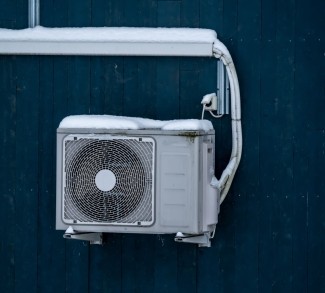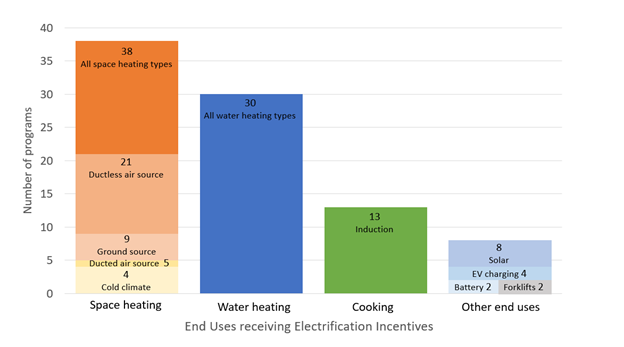Cold winters are common in Minnesota, where temperatures stay well below freezing for many months of the year. That’s one reason it’s surprising that Minnesota has recently become one of the latest states to pass a law encouraging residents to install efficient electric heat pumps, a technology that until recently was believed to be incompatible with cold climates. Now organizations such as the Minnesota Air Source Heat Pump Collaborative are working to expand the use of this technology to replace fossil fuels in buildings—and they’re not the only ones.
Municipal utilities such as the Burlington Electric Department in Burlington, Vermont, are thinking critically about electrification and converting fossil fuels used in buildings to efficient electric alternatives. With ambitious climate goals of reducing building-, water-, and transportation-related emissions 50% by 2030, Burlington is taking steps to encourage its residents to switch to heat pumps, smart water heaters, and even electric lawnmowers.
Across the United States, as a new ACEEE report shows, cities, states, utilities, and nonprofits are increasing efforts to electrify the buildings sector, where the burning of fossil fuels for space heating, water heating, cooking, and other uses accounts for 13% of total U.S. greenhouse gases (GHG) emissions. By replacing fossil fuels with electric equivalents, and “greening the grid” by switching electricity generation to carbon-free energy sources, these efforts are becoming a powerful strategy in the fight against climate change.
Our report analyzes 42 such programs in the residential, multifamily, and commercial sectors and identifies trends, common approaches, and best practices. Though these programs are mainly found in states with ambitious climate targets, such as California and New York, there are examples of electrification efforts in many states across multiple climates, regions, and political environments, as shown in the map below.
Targets and Methods Vary
As any homeowner can attest, building improvements are hardly a simple or inexpensive process, and electrification is no exception. Our report finds that most electrification efforts focus primarily on space heating and hot water, which together represent the two largest direct uses of fossil fuels and corresponding sources of GHG emissions in buildings in the United States.
Other measures are less common in the programs we surveyed. Replacing gas-fired stoves with electric induction ranges, for example, features in about a third of programs. Finally, more than half of the programs combine electrification with conventional energy efficiency and weatherization measures, a tried-and-true approach that can make electric heat even more cost-effective and achieve higher carbon reductions from reduced energy waste.
Program implementers use incentives more than any other method to encourage customers to adopt these technologies. The incentives help reduce the up-front cost of the equipment, which can sometimes be more expensive than a fossil-fueled furnace or boiler even if it is cheaper to operate in the long run.
However, some programs use a different strategy. The Association for Energy Affordability in California is a nonprofit organization that since 2014 has worked with property managers and communities to upgrade low-income apartment complexes with energy efficiency, electrification, solar power, and other improvements that substantially reduce residents’ energy bills and GHG emissions.
This program, the Low Income Weatherization Program for Multifamily Properties, is funded through California’s cap-and-trade markets, meaning that the fees paid by some of the biggest contributors to climate change directly support GHG reductions and quality-of-life improvements for the state’s marginalized communities and residents.
Barriers Remain
One of the first barriers for customers looking to adopt electric space- and water-heating equipment is cost. High-efficiency heat pumps for space and water heating are often more expensive than conventional gas furnaces and boilers and may be more costly to operate in regions where the price of electricity is high relative to the price of natural gas.
Many of the programs in this study attempt to lower this up-front cost by offering rebates to customers. Most also recommend customers weatherize and insulate their homes, which further reduces operating costs. The economics of electrification are generally more favorable when displacing unregulated fuels like oil or propane. When building a new home, going all-electric is swiftly becoming the cheapest option for both homebuilders and future residents.
While the up-front cost of electrification is an important barrier to overcome, it is far from the only consideration that program administrators must make in order to scale up electrification in buildings. Across the nation, too few contractors, electricians, and plumbers are trained and motivated to install heat pumps and water heaters in customer homes. In New York, for example, homeowners who are interested in electrification are having trouble finding a contractor who is able and willing to do the work it takes to switch from fossil fuels to all-electric heat. That is why some organizations, such as the Minnesota ASHP Collaborative and NYSERDA offer job-training programs, peer networks, and incentives for contractors to gain familiarity with and certification in installing all-electric home technologies.
In addition, for electrification technologies like heat pumps to take off and grow quickly across the nation, customers need to be interested and willing to adopt them in their homes. In a survey of residential HVAC customers, 87% of respondents did not know or were unclear about the difference between mini-split heat pumps and traditional HVAC systems. Also, when a furnace or an air conditioner breaks, many customers will choose only to replace the broken part rather than the entire system.
These decisions—often made on an emergency basis—can unintentionally lock in fossil fuels and their associated carbon emissions for sometimes 15 years or more. Education and consumer outreach are vital steps for program implementers who are interested in growing demand for building electrification.
Although the market for building electrification is developing rapidly, we still have a long way to go in order to retrofit the tens of millions of homes that currently rely on outdated, polluting, and often costly fossil fuels. Electrification offers multiple benefits: Electric heat pumps provide air-conditioning as well as heating; electric water heaters that are grid-interactive allow homeowners to save money and reduce peak electricity demand on the grid; and induction cooking, more efficient and safer than gas or electric resistance stoves, allows precise control and rapid cooling of surfaces to avoid accidental burns and hazardous gas leaks.
These benefits show us that electrification is a climate strategy that doesn’t require compromises in quality of life. But getting to full building electrification requires everybody to play a part: from policymakers to utilities, to manufacturers, distributors, contractors, and homeowners. The lessons learned from past efforts can help us construct a pathway to a cleaner future, but our work must begin today.
Building Electrification: Programs and Best Practices →




